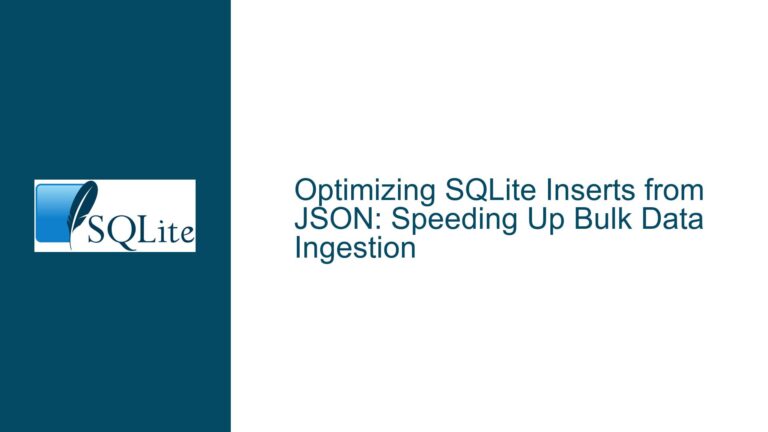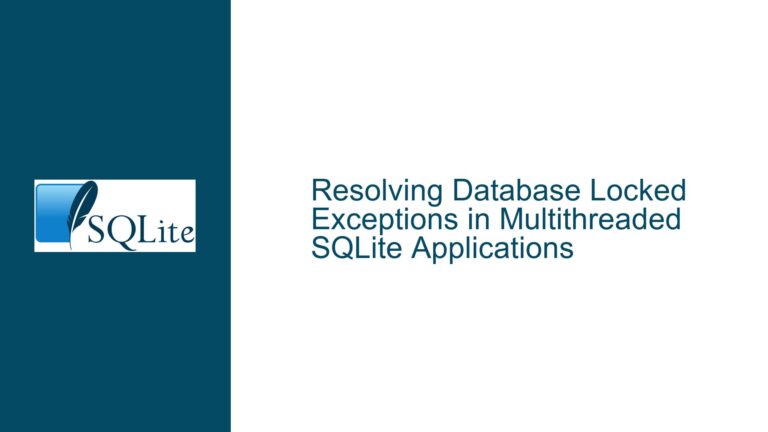Optimizing SQLite for High-Concurrency Read-Only Workloads in Cloud Environments
SQLite’s Single-Threaded Nature and Its Impact on Parallel Page Fetching
SQLite is designed as an in-process, serverless database engine, which means it operates entirely within the context of the calling thread. This design choice has significant implications for how SQLite handles I/O operations, particularly in high-concurrency environments such as cloud-based applications. SQLite does not inherently support parallel page fetching or asynchronous I/O. Instead, it performs all operations sequentially on the thread that makes the call into the SQLite library. This includes fetching pages from disk, which is done one page at a time, as needed, and only when the page is not already in the SQLite page cache.
The SQLite page cache is a critical component of its performance. When a page is needed, SQLite first checks if it is already in the cache. If not, it issues a synchronous I/O request to fetch the page from disk. This request is handled by the operating system, which may perform optimizations such as read-ahead or batching, but from SQLite’s perspective, the operation is strictly serial. This means that even if multiple pages are needed to satisfy a query, SQLite will fetch them one after the other, rather than issuing multiple I/O requests in parallel.
This serial nature of SQLite’s I/O operations can become a bottleneck in environments where the database is stored on a high-latency network filesystem, such as AWS EFS (Elastic File System). In such cases, the time spent waiting for each page to be fetched from the network can add up, leading to suboptimal performance for read-heavy workloads. While SQLite does allow multiple connections to the same database file, each connection operates independently, and there is no coordination between them to optimize I/O operations.
The Challenges of Parallelizing SQLite for Network-Bound Workloads
The primary challenge in optimizing SQLite for high-concurrency, read-only workloads in cloud environments lies in its single-threaded, synchronous I/O model. SQLite was not designed with the expectation that it would be used in scenarios where the database is stored on a high-latency network filesystem. As a result, its architecture does not lend itself easily to parallelization or asynchronous I/O.
One potential approach to improving performance in such environments is to use multiple SQLite connections, each running in its own thread or process. This can be achieved using Node.js worker threads, where each worker has its own SQLite connection to the same database file. Since SQLite allows multiple readers to access the database concurrently, this approach can provide some degree of parallelism. However, it is important to note that each SQLite connection operates independently, and there is no shared page cache or coordination between connections. This means that if multiple connections need to fetch the same page from disk, each connection will issue its own I/O request, potentially leading to redundant I/O operations.
Another challenge is the lack of support for asynchronous I/O in SQLite. In a typical Node.js application, I/O operations are handled asynchronously using the event loop, which allows the application to continue processing other tasks while waiting for I/O to complete. However, SQLite’s I/O operations are synchronous, meaning that they block the calling thread until the operation is complete. This can lead to inefficiencies in a Node.js application, where the event loop may be blocked by long-running SQLite queries.
Strategies for Improving SQLite Performance in High-Concurrency Environments
Given the limitations of SQLite’s architecture, there are several strategies that can be employed to improve its performance in high-concurrency, read-only workloads in cloud environments. These strategies focus on minimizing the impact of SQLite’s single-threaded, synchronous I/O model, while leveraging the capabilities of the underlying operating system and cloud infrastructure.
1. Pre-Warming the SQLite Page Cache
One effective strategy for reducing the impact of SQLite’s synchronous I/O model is to pre-warm the SQLite page cache. This involves loading the pages that are likely to be needed by queries into the cache before they are actually requested. For example, if a query is expected to scan a large portion of a table, the application can issue a series of SELECT statements to fetch the relevant pages into the cache. This can be done in a background thread or process, allowing the main application to continue processing other tasks while the cache is being warmed.
Pre-warming the cache can be particularly effective in read-only workloads, where the data does not change frequently. By ensuring that the necessary pages are already in the cache when a query is executed, the application can avoid the latency associated with fetching pages from disk. However, it is important to note that pre-warming the cache requires careful planning and monitoring, as it can consume a significant amount of memory.
2. Optimizing the SQLite Page Size
Another strategy for improving SQLite’s performance in high-concurrency environments is to optimize the page size used by the database. The page size determines how much data is read from disk in a single I/O operation. By increasing the page size, the application can reduce the number of I/O operations required to fetch a given amount of data. This can be particularly beneficial in network-bound workloads, where the latency of each I/O operation is high.
However, increasing the page size also has trade-offs. Larger pages consume more memory, both in the SQLite page cache and in the operating system’s buffer cache. Additionally, larger pages can lead to increased contention for the database file, as each I/O operation locks a larger portion of the file. Therefore, it is important to carefully balance the page size with the available memory and the expected concurrency of the workload.
3. Using Multiple SQLite Connections with Worker Threads
As mentioned earlier, one way to achieve parallelism in SQLite is to use multiple connections, each running in its own thread or process. In a Node.js application, this can be achieved using worker threads, where each worker has its own SQLite connection to the same database file. By distributing the workload across multiple workers, the application can take advantage of multiple CPU cores and reduce the overall time required to execute queries.
However, it is important to manage the number of worker threads carefully. Each SQLite connection consumes memory and other resources, and creating too many connections can lead to resource exhaustion. Additionally, each connection operates independently, so there is no coordination between them to optimize I/O operations. Therefore, it is important to use a worker pool to limit the number of concurrent connections and ensure that resources are used efficiently.
4. Leveraging the Operating System’s I/O Optimizations
While SQLite itself does not support asynchronous I/O or parallel page fetching, the underlying operating system may provide optimizations that can improve performance. For example, modern operating systems often perform read-ahead or batching of I/O operations, which can reduce the impact of SQLite’s synchronous I/O model. Additionally, the operating system’s buffer cache can help reduce the number of I/O operations required by caching frequently accessed pages.
In a cloud environment, it is also important to consider the performance characteristics of the network filesystem being used. For example, AWS EFS is designed to provide high throughput and low latency for large-scale, read-heavy workloads. By understanding the performance characteristics of the filesystem, the application can be tuned to take advantage of its strengths and minimize its weaknesses.
5. Exploring Alternative Database Solutions
Finally, it is worth considering whether SQLite is the best choice for a given workload. While SQLite is a powerful and flexible database engine, it is not designed for high-concurrency, network-bound workloads. In some cases, it may be more effective to use a distributed database solution that is specifically designed for such environments. For example, distributed SQLite variants such as BedrockDB, rqlite, and dqlite provide additional features such as replication and distributed transactions, which can improve performance and scalability in cloud environments.
However, it is important to note that these solutions come with their own trade-offs, such as increased complexity and potential consistency issues. Therefore, it is important to carefully evaluate the requirements of the workload and choose the database solution that best meets those requirements.
Conclusion
SQLite is a powerful and flexible database engine, but its single-threaded, synchronous I/O model can become a bottleneck in high-concurrency, read-only workloads in cloud environments. By understanding the limitations of SQLite’s architecture and employing strategies such as pre-warming the page cache, optimizing the page size, using multiple SQLite connections with worker threads, leveraging the operating system’s I/O optimizations, and exploring alternative database solutions, it is possible to improve SQLite’s performance in these challenging environments. However, it is important to carefully evaluate the trade-offs of each strategy and choose the approach that best meets the requirements of the workload.






